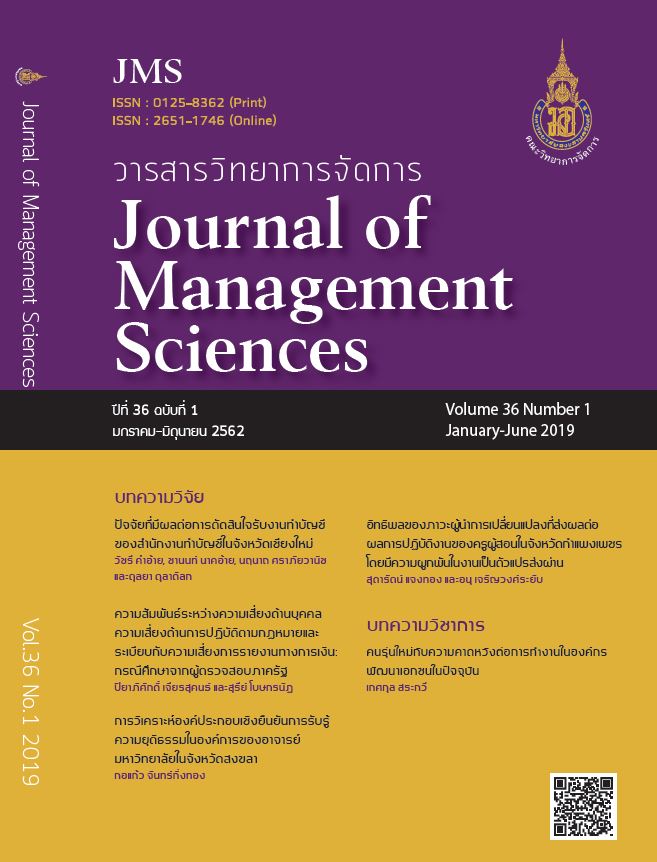การวิเคราะห์องค์ประกอบเชิงยืนยันการรับรู้ความยุติธรรมในองค์การของอาจารย์มหาวิทยาลัยในจังหวัดสงขลา
Main Article Content
บทคัดย่อ
การศึกษานี้มีวัตถุประสงค์เพื่อตรวจสอบความสอดคล้องกลมกลืนของโมเดลการรับรู้ความยุติธรรมในองค์การของอาจารย์มหาวิทยาลัยในจังหวัดสงขลากับข้อมูลเชิงประจักษ์ เก็บข้อมูลกับอาจารย์มหาวิทยาลัยในจังหวัดสงขลา ได้แก่ มหาวิทยาลัยทักษิณ มหาวิทยาลัยราชภัฏสงขลา มหาวิทยาลัยเทคโนโลยีราชมงคลศรีวิชัย มหาวิทยาลัยสงขลานครินทร์ และมหาวิทยาลัยหาดใหญ่ จำนวน 400 คน โดยใช้แบบสอบถามมาตราส่วนประเมินค่า 5 ระดับ จำนวน 18 ข้อ มีค่าความเชื่อมั่นของแบบสอบถามอยู่ระหว่าง .90-.94 ทำการวิเคราะห์ข้อมูลโดยใช้เทคนิคการวิเคราะห์องค์ประกอบเชิงยืนยันอันดับสอง (Second Order Confirmatory Factor Analysis) ผลการวิจัยพบว่า การรับรู้ความยุติธรรมในองค์การของอาจารย์มหาวิทยาลัยในจังหวัดสงขลา มี 3 องค์ประกอบหลัก คือ (1) การรับรู้ความยุติธรรมด้านการแบ่งปันผลตอบแทนขององค์การ มี 5 องค์ประกอบย่อย (2) การรับรู้ความยุติธรรมด้านกระบวนการขององค์การ มี 7 องค์ประกอบย่อย และ (3) การรับรู้ความยุติธรรมด้านปฏิสัมพันธ์ระหว่างบุคคลกับองค์การ มี 6 องค์ประกอบย่อย นอกจากนี้ยังพบอีกว่า องค์ประกอบหลักทั้ง 3 องค์ประกอบมีความสอดคล้องกลมกลืนกับข้อมูลเชิงประจักษ์ โดยมีค่าดัชนีความกลมกลืน คือ X2 (df = 123) = 372.20 sig = 0.00, X2/df = 3.03, CFI = 0.98, NNFI = 0.97, RMSEA = 0.07, SRMR = 0.05 โดยองค์ประกอบหลักทั้ง 3 ตัว และองค์ประกอบย่อยทั้ง 18 ตัว มีค่าสัมประสิทธิ์องค์ประกอบคะแนนมาตรฐานอยู่ระหว่าง .84 - .99 และ .61 - .83 ตามลำดับ ซึ่งเป็นหลักฐานเชิงประจักษ์ในการยืนยันถึงการวัดการรับรู้ความยุติธรรมในองค์การว่าประกอบด้วย 3 องค์ประกอบหลัก เพื่อนำไปสู่แนวทางการจูงใจบุคลากรในการทุ่มเทความสามารถในการปฏิบัติงาน
Article Details

อนุญาตภายใต้เงื่อนไข Creative Commons Attribution-NonCommercial-NoDerivatives 4.0 International License.
บทความที่ตีพิมพ์ถือเป็นลิขสิทธิ์ของวารสารวิทยาการจัดการ มหาวิทยาลัยสงขลานครินทร์ อย่างไรก็ตาม กองบรรณาธิการไม่สงวนลิขสิทธิ์ในการทำซ้ำ คัดลอก หรือเผยแพร่ แต่จะต้องอ้างอิงให้ถูกต้องตามหลักวิชาการ
เอกสารอ้างอิง
Bies, R. J. & Moag, J. F. (1986). Interactional justice: Communication criteria of fairness. In R. J. Lewicki, B. H. Sheppard, & M. H. Bazerman (Eds.), Research on Negotiations in Organizations (pp. 43-55). Greenwich, CT: JAI Press.
Cohen-Charash, Y. & Spector, P. E. (2001). The role of justice in organizations: A meta analysis. Organizational Behavior and Human Decision Processes, 86(2), 278-321.
Colquitt, J. A. (2001). On the dimensionality of organizational justice: A construct validation of a measure. Journal of Applied Psychology, 86(3), 386-400.
De Cremer, D., Van Dijke, M., & Bos, A. E. R. (2007). When leaders are seen as transformational: The effects of organizational justice. Journal of Applied Social Psychology, 37(8), 1797-1816.
Diamantopoulos, A. & Siguaw, J. A. (2000). Introducing LISREL: A guide for the uninitiated. Thousan Oaks. CA: Sage.
Fiaz, M., Ikram, A., Su, Q., & Ali, N. (2018). How to save the saviors?: Relationship between organizational justice and citizenship behavior. The Journal of Developing Areas, 52(1), 45-58.
Folger, R. & Greenberg, J. (1985). Procedural justice: An interpretive analysis of personnel system. In K. M. Rowland & G. R. Ferris (Eds.), Research in personnel and human resource management (pp. 141-183). Greenwich, CT: JIT Press.
Hair, J. F., Black, W. C., Babin, B. J., & Anderson, R. E. (2010). Multivariate data analysis: A global perspective. (7th ed.) Upper Saddle River, NJ: Pearson Education.
Inoue, A., Kawakami, N., Tsutsumi, A., Shimazu, A., Tsuchiya, M., Ishizaki, M., et al. (2009). Reliability and validity of the Japanese version of the organizational justice questionnaire. Journal of Occupational Health, 51(1), 74-83.
Jankingthong, K. (2016). Structural equation model of the relationship of behavior toward the polices’ performance in Southern Border Province of Thailand, Journal of Management Science. 33(1), 1-24.
Kline, R. B. (2011). Principle and practice of structural equation modeling. (3rd ed.). New York, NY: Guilford.
Kreitner, R. & Kinicki, A. (2004). Organizational behavior. (6th ed.). New York, NY: McGraw-Hill.
Lakpetch, P. (2014). Multi-level confirmatory factor analysis of five-forces model in hotel industry of Thailand for ASEAN Economic Community. Journal of Research Methodology, 27(3), 281-301.
Moorman, R. H. (1991). Relationship between organizational justice and organizational citizenship behaviors: Do fairness perceptions influence employee citizenship?. Journal of Applied Psychology, 76(6), 845-855.
Muchinsky, P. M. (2006). Psychology applied to work: An introduction to industrial and organizational psychology (8th ed.). Belmont, CA: Thomson/Wadsworth.
Ngudgratoke, S. (2014). Analysis for applied research (2nd ed.).Journal of Research Methodology, 27(3), 363-368.
Niehoff, B. P. & Moorman, R. H. (1993). Justice as a mediator of the relationship between methods of monitoring and organizational citizenship behavior. Academy of Management Journal, 36(3), 527-556.
Noklang, S., Srisuantang, S., & Tonpichai, P. (2015). A confirmatory factor analysis model of adversity quotient among third year students in the five-year teacher education course at Prince of Songkla University, Pattani Campus. Journal of Liberal Arts, 7(1), 109-125.
Robbins, S. P. (2003). Organizational behavior. (10th ed.). Upper Saddle River, NJ: Pearson Education.
Schumacker, R. E. & Lomax, R. G. (2010). A beginner’s guide to structural equation modeling (3rd ed.). New York, NY: Taylor & Francis.
Somanandana, V., Purananon, D., Wongnam, P., & Surasret, C. (2016). Confirmatory factor analysis of Tri-Sikkhara characteristics of college students. Suthiparithat, 30(94), 168-179.
Sutanto, E. M., Scheller-Sampson, J., & Mulyono, F. (2018). Organizational justice work environment and motivation. International Journal of Business and Society, 19(2). 313-322.
Wang, X., Liao, J., Xia, D., & Chang, T. (2010). The impact of organizational justice on work performance. International Journal of Manpower, 31(6), 660-677.

